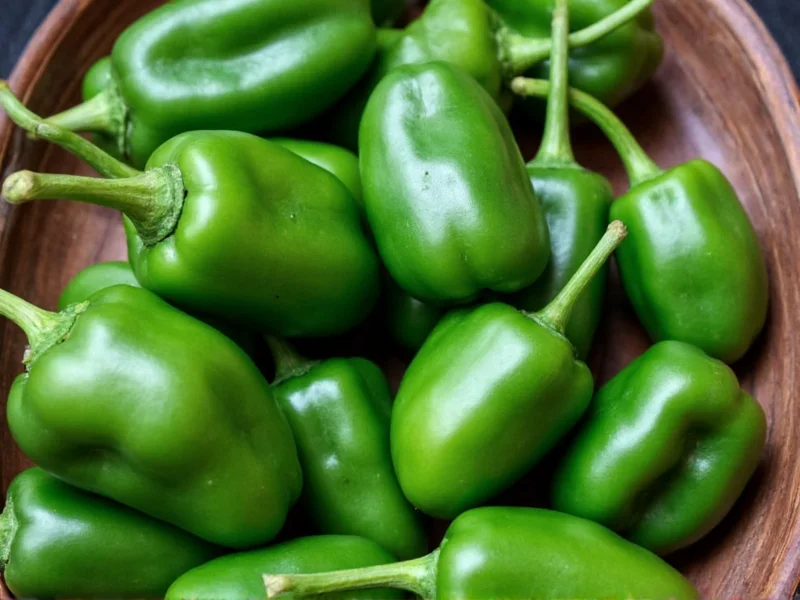No, pasilla peppers and poblano peppers are not the same. Poblano peppers are fresh, large, dark green chilies, while pasilla peppers are actually dried chilaca peppers. The confusion arises because dried poblanos are sometimes incorrectly labeled as “pasilla” in certain regions, but true pasilla peppers come from a different variety altogether.
When exploring Mexican cuisine or shopping for ingredients, you've likely encountered both pasilla and poblano peppers and wondered about their relationship. This confusion is understandable given inconsistent labeling practices, but understanding the distinction is crucial for authentic cooking and proper recipe execution. Let's clarify the botanical realities, culinary applications, and common misconceptions surrounding these two essential Mexican peppers.
Botanical Identity: Setting the Record Straight
The poblano pepper ( Capsicum annuum) is a large, heart-shaped chili that starts dark green and matures to red, brown, or even purplish hues. Fresh poblanos measure 2.5–4 inches wide and 4–6 inches long with thick walls. When dried, they transform into ancho peppers—not pasillas. This mislabeling causes significant confusion in grocery stores, particularly in the United States.
True pasilla peppers originate from the chilaca variety (Capsicum annuum), which is long (6–8 inches), narrow, and dark green when fresh. As chilacas mature and dry, they become wrinkled, dark brown to black, and develop their signature “little raisin” appearance—which is what “pasilla” means in Spanish. Pasillas offer complex flavors of dried fruit, licorice, and tobacco with moderate heat (1,000–2,500 Scoville units).
Visual and Flavor Comparison
To help distinguish these peppers at a glance, here's a detailed comparison of their characteristics:
| Characteristic | Poblano Pepper | Pasilla Pepper |
|---|---|---|
| Botanical Name | Capsicum annuum (fresh) | Capsicum annuum (dried chilaca) |
| Physical Form | Fresh green pepper | Dried pepper (never sold fresh as “pasilla”) |
| Size | 4–6 inches long, 2.5–4 inches wide | 6–8 inches long, narrow and wrinkled |
| Color | Dark green (fresh), turns red when mature | Dark brown to black (dried) |
| Heat Level | Mild (1,000–2,000 Scoville) | Mild to medium (1,000–2,500 Scoville) |
| Flavor Profile | Earthy, slightly sweet, grassy notes | Complex: dried fruit, licorice, tobacco, berry notes |
| Common Mislabeling | Dried poblanos incorrectly sold as “pasilla” | True pasilla rarely mislabeled |
Why the Confusion Exists
The primary reason for confusion between pasilla peppers and poblano peppers stems from regional labeling practices, particularly in the United States. In Mexico, the terminology remains consistent: fresh chilacas become pasillas when dried, while fresh poblanos become anchos when dried. However, some American grocers mistakenly label dried poblanos as “pasilla peppers,” creating widespread misunderstanding.
This mislabeling has become so prevalent that many English-language recipes use “pasilla” to refer to dried poblanos, further muddying the waters. When shopping for authentic Mexican ingredients, always check whether you're getting dried chilaca (true pasilla) or dried poblano (ancho), as their flavor profiles differ significantly in traditional dishes.
Culinary Applications and Substitutions
Understanding the difference between pasilla and poblano peppers is essential for proper recipe execution. Poblanos shine when roasted and stuffed (like in chiles rellenos), added fresh to salsas, or incorporated into casseroles. Their mild heat and thick walls make them ideal for handling and stuffing.
Pasilla peppers, with their complex dried fruit notes, form the backbone of traditional Mexican mole sauces, particularly mole negro. They're typically rehydrated and blended into sauces rather than used whole. If you're following a recipe calling for pasilla peppers but only have anchos (dried poblanos), expect a noticeably different flavor profile—anchos offer raisin-like sweetness while pasillas provide deeper, smokier notes.
For substitution guidance:
- When a recipe calls for fresh poblano: Bell peppers or anaheim peppers work as mild substitutes
- When a recipe calls for true pasilla (dried chilaca): Mulato peppers offer the closest flavor match
- When a recipe mistakenly calls for “pasilla” but means ancho (dried poblano): Guajillo peppers provide a similar heat level
Shopping Tips for Authentic Ingredients
To avoid confusion when purchasing these peppers, follow these practical guidelines:
When buying fresh poblanos, look for firm, dark green peppers with smooth, glossy skin. They should feel heavy for their size with no soft spots. Poblanos are typically sold fresh in the produce section.
When seeking true pasilla peppers, examine the dried chili section carefully. Authentic pasillas will be long, narrow, deeply wrinkled, and dark brown to black. They should have a complex aroma with notes of dried fruit and earth. If the label simply says “pasilla” without specifying “dried chilaca,” check the appearance—if they're wide and heart-shaped, they're likely mislabeled dried poblanos (anchos).
For the most authentic experience, consider visiting a Mexican mercado or specialty store where staff can clarify the pepper varieties. Online retailers specializing in Mexican ingredients often provide detailed descriptions that help avoid confusion between pasilla vs poblano peppers and their dried counterparts.
Growing Your Own: Different Cultivation Needs
If you're interested in growing these peppers, understand they have different cultivation requirements. Poblano plants grow to about 2–3 feet tall with broad leaves, producing large, downward-hanging fruit. They require 65–80 days to maturity and prefer warm temperatures.
Chilaca plants (which become pasillas when dried) grow slightly taller at 3–4 feet with narrower leaves. The long, thin chilaca peppers mature more slowly—taking 70–90 days—and hang downward from the plant. Both varieties need full sun and well-draining soil, but chilacas tend to be slightly more heat-tolerant.
When harvesting for drying (to make true pasillas), allow chilaca peppers to fully mature on the plant until they turn deep red and begin to wrinkle slightly before picking and air-drying. Poblanos intended for drying (to make anchos) should be harvested when fully red but still smooth.











 浙公网安备
33010002000092号
浙公网安备
33010002000092号 浙B2-20120091-4
浙B2-20120091-4